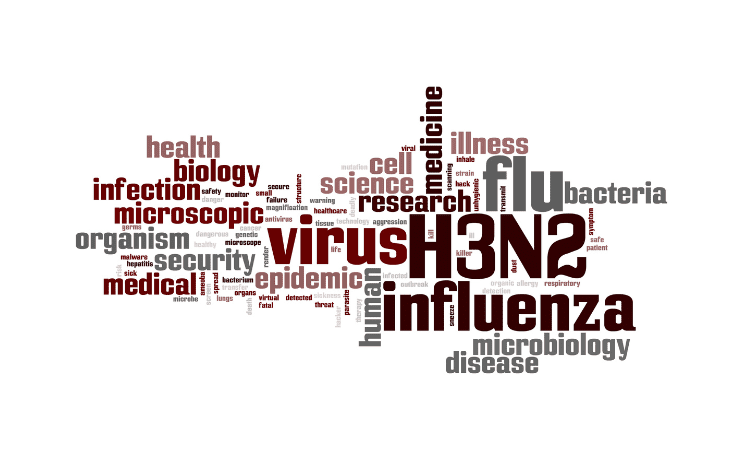H3N2: The History, Symptoms, Diagnosis, Treatment, and Prevention

H3N2: The History, Symptoms, Diagnosis, Treatment, and Prevention
TABLE OF CONTENTS
• Symptoms of h3n2
• Diagnosis of h3n2
• Prevention of h3n2
• Treatment for h3n2
• Comparison with covid-19
• Conclusion
SYMPTOMS OF H3N2
Fever: A high temperature of 100.4°F or higher is a common symptom of H3N2. The fever can last for several days and may be accompanied by chills.
Cough: H3N2 can cause a dry, persistent cough that may worsen over time. The cough can be severe and may make it difficult to breathe or sleep.
Sore throat: Individuals with H3N2 may experience a sore throat, which can be accompanied by pain, redness, or swelling in the throat.
Headache: H3N2 can cause a headache that is often severe and persistent. The headache may be accompanied by other symptoms such as fatigue or body aches.
Muscle aches: H3N2 can cause muscle aches and stiffness throughout the body, including the back, legs, and arms.
Fatigue: Individuals with H3N2 may feel very tired and weak, which can make it difficult to perform daily tasks or even get out of bed.
Runny or stuffy nose: H3N2 can cause nasal congestion, sneezing, and a runny nose, similar to the symptoms of a common cold.
DIAGNOSIS OF H3N2
H3N2 is a type of influenza virus that can cause respiratory illness in humans. While the diagnosis of H3N2 can be based on clinical symptoms and a physical examination, blood tests can also be used to confirm the presence of the virus.
The blood test used to diagnose H3N2 is a qualitative RT PCR Panel. It comprises many tests like influenza A, Influenza B, and H3N2 virus. The sample required for this test is nasal and throat swabs and labs usually take 24 to 48 hours for the results. This test detects the genetic material of the virus in a sample of respiratory secretions, including nasal or throat swabs. PCR tests are highly sensitive and specific, meaning they can accurately detect the presence of H3N2 and differentiate it from other types of influenza viruses.
.
Additional blood tests like complete blood count(CBC), Erythrocyte sedimentation rate(ESR), Liver function test(LFT), and C-reactive protein(CRP) are also done to check the effects of virus on the normal functioning of the body.
PREVENTION OF H3N2
Vaccination: Getting vaccinated against influenza is the best way to prevent H3N2 infection. The influenza vaccine is updated every year to protect against the most common strains of the virus, including H3N2.
Good hygiene practices: Washing your hands frequently with soap and water or using an alcohol-based hand sanitizer can help prevent the spread of H3N2. Covering your mouth and nose with a tissue or your sleeve when coughing or sneezing can also help prevent the virus from spreading to others.
Avoiding close contact with sick individuals: If you know someone who has H3N2 or any other type of influenza, it is best to avoid close contact with them until they are no longer contagious.
Staying home when you are sick: If you have symptoms of H3N2, it is important to stay home and avoid contact with others until you are no longer contagious.
Cleaning and disinfecting frequently touched surfaces: The H3N2 virus can survive on surfaces for several hours, so it is important to regularly clean and disinfect frequently touched surfaces, such as doorknobs, light switches, and countertops.
Boosting your immune system: Eating a healthy diet, getting regular exercise, and getting enough sleep can all help boost your immune system, making you less susceptible to H3N2 and
TREATMENT FOR H3N2
It is important to note that antiviral medications work best when taken within 48 hours of the onset of symptoms, so it is important to seek medical attention as soon as possible if you suspect you have been infected with H3N2.
In addition to antiviral medications, treatment for H3N2 may also involve supportive care, such as rest, hydration, and over-the-counter pain relievers to help manage fever and body aches.
COMPARISON WITH COVID-19
COVID-19 is primarily spread through respiratory droplets that are produced when an infected person talks, coughs, or sneezes. H3N2 is also spread through respiratory droplets, but it can also be spread through contact with surfaces contaminated with the virus.
While both illnesses can cause similar symptoms, such as fever, cough, and body aches, COVID-19 can also cause loss of taste or smell, shortness of breath, and fatigue. H3N2 typically causes more severe symptoms in older adults and young children.
COVID-19 has a higher mortality rate than H3N2. According to the World Health Organization (WHO), the global mortality rate for COVID-19 is estimated to be between 1% and 3%, while the mortality rate for H3N2 is less than 0.1%.
Both illnesses can be prevented with vaccines. COVID-19 vaccines have been developed to specifically target the SARS-CoV-2 virus, which causes COVID-19, while influenza vaccines are developed each year to protect against the specific strains of the influenza virus that are predicted to be most prevalent that season.
Antiviral medications are available to treat both illnesses, but COVID-19 also has additional treatment options, such as monoclonal antibodies and antiviral drugs like remdesivir.
